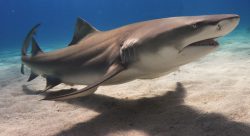select your film:


Lemon Sharks are named after its bright yellow or brown pigmentation.
They are often found in shallow waters no deeper than 92 m near coasts off islands, bays, coral reefs, mangrove fringes and sometimes at the mouth of rivers.
They are common in the Atlantic Ocean along the coasts of the United States to Brazil, some areas on the West African coast and in the Pacific Ocean from Baja California to Ecuador.
Biology and Behaviour:
A fully grown lemon shark is about 350 m from head to tail and can weigh 420 pounds. Though they are commonly 240 cm to 310 cm.
Like many other sharks, lemon sharks have electroreceptors that allow them to track prey using electric impulses that every living species emit. Lemon sharks have an excellent sense of smell which makes up for their poor vision.
They are nocturnal feeders that prey on fish and sometimes crustaceans and molluscs. They congregate in groups because it enhances their communication, courtship, predatory behaviour and provides protection.
Lemon sharks have a flattened head with a short, broad snout and the second dorsal fin is almost as large as the first.
Young lemon sharks are more attached to their habitats than adults who will migrate far and deep in the water in the winter time.
Reproduction and Lifespan:
Lemon sharks are viviparous. Females are polyandrous and have a biennial reproduction cycle. Mating occurs in spring and summer and females gestate between ten to 12 months.
Female lemon sharks give birth between four to 17 pups who are about 50 cm to 60 cm at birth. Male lemon sharks mature around 12 years at 225 cm while female mature a little later around 13 years at 235 cm.
Conservation and Tourism:
Lemon sharks are caught commercially on long lines for their meat and their fins, and sometimes for recreational purposes. They are popular sharks at aquariums and used for research.
The IUCN lists lemon sharks as near threatened, but there are no conservation actions in place.
Do you have images or videos of Lemon Sharks?
Submit them to [email protected].
